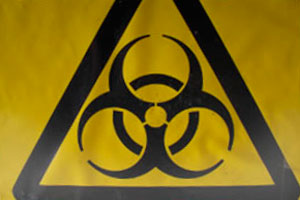
Hazardous Waste Warning
LessIsMore.org works best in modern browsers like Firefox, Safari, Chrome, or Internet Explorer 8. All are free to download and will greatly improve your internet experience. Wastes in this section are dangerous to you and the environment. Handle them carefully and dispose of them properly. Legally, households may not transport more than 15 gallons of wet or 125 pounds of dry hazardous materials. Read about the regulation.
Cleaning Products
While we may not think of them as hazardous, cleaning products often contain chemicals that can be harmful if not used properly. Think about the labels you see on products like oven cleaners and bleach:
- "Hazards to humans and domestic animals"
- "Skin and eye irritant"
- "Harmful if swallowed"
These products should always be used for their intended purpose only and you should NEVER MIX two products together. Case in point: Combining bleach (e.g. Clorox) and ammonia (e.g. Windex) creates toxic chlorine gas. Yikes!
What about alternative, less-toxic cleaners?
In the past few years, the demand for less-toxic products has steadily grown. Product manufacturers are responding by introducing new cleaners that are more environmentally friendly and that contain fewer harsh chemicals. If you choose to purchase these products, make sure to read the label for disposal instructions. Better yet, eliminate the need for disposal by using up the entire product.
Can I make my own household cleaners?
Absolutely! You probably have many of the essential ingredients in your kitchen. Common staples like vinegar, baking soda, and lemon juice go a long way toward cleaning countertops, sinks, ovens, windows, drains, and toilet bowls. For quick homemade recipes, check out Eco-Cycle's website.
Where to go
-
All of Santa Barbara County (1)
- Safety Kleen — 5310 Overpass Road
-
Santa Barbara Area (1)
- *Community Hazardous Waste Collection Center — University of California, Environmental Health and Safety Building, Building 565, Mesa Road
-
Goleta & UCSB Area (1)
- *Community Hazardous Waste Collection Center — University of California, Environmental Health and Safety Building, Building 565, Mesa Road
-
Lompoc Valley & VAFB (1)
- City of Lompoc Household Hazardous Waste Collection Facility — 1585 N. "V" St
-
Santa Maria Valley (1)
- City of Santa Maria Household Hazardous Waste Facility — 2065 East Main Street
-
Outside Santa Barbara County (7)
- Asbury Environmental Services — 2100 North Alameda Street
- BGI — 527 North Rice Avenue
- C.J. Seto Support Services, LLC — 2300 Knoll Dr, Unit G
- Clean Harbors, Inc. — 880 W Verdulera St
- Earth911.com – Information Only — 3481 Plano Parkway
- Industrial Waste Utilization — 5601 State Street
- Stericycle, Incorporated —
Related Materials
- Santa Ynez Valley Collection Event
- Recycling Resource Guide
- Solvents and Adhesives
- Pool Supplies
- Cleaning Products
- Aerosol Cans (with contents)
Related Articles
-
April 7th Hazardous Waste Collection Event
March 03, 2019 by Leslie Robinson - Hazardous Waste Recycling/Disposal -
Holiday Facility Closures
December 20, 2023 by Tori Kampmann - Hazardous Waste Recycling/Disposal -
“Less Is More” Guide Hot Off the Press
January 18, 2023 by Kaitlyn Haberlin - Recycle, Reduce & Reuse -
America Recycles Day November 15th
November 08, 2019 by Leslie Robinson - Recycle -
Latest Annual Report Available for County’s Hazardous Waste Collection Program
January 10, 2024 by Tori Kampmann - Hazardous Waste Recycling/Disposal -
Free Recycling Centers Available for Motor Oil and Filters
March 19, 2018 by Leslie Robinson - Hazardous Waste Recycling/Disposal -
Thomas Fire Clean-Up Tips & Guidelines
-
Thanksgiving Facility Closures
November 22, 2023 by Tori Kampmann - Hazardous Waste Recycling/Disposal -
RRWM’s Annual Waste Management Report Now Available
October 05, 2017 by Alan Nakashima - Recycle -
Easy Battery Recycling at Curbside
May 31, 2019 by Jody Rundle - Hazardous Waste Recycling/Disposal -
Battery Recycling Made Easy
November 30, 2015 by Jody Rundle - Hazardous Waste Recycling/Disposal -
Free Hazardous Waste Events October 5 & 6
September 30, 2019 by Leslie Robinson -
Reminder: Santa Ynez Valley Hazardous Waste Collection Event Postponed
March 23, 2020 by Leslie Robinson -
Hazardous Waste Collection Center Temporarily Closed – Updated 3/30/20
March 30, 2020 by Leslie Robinson - Hazardous Waste Recycling/Disposal -
Hazardous Waste Disposal Options in Santa Barbara County
June 04, 2021 by Tori Kampmann - Hazardous Waste Recycling/Disposal -
FREE Household Hazardous Waste Event!
March 31, 2024 by Kaitlyn Haberlin - Hazardous Waste Recycling/Disposal -
New Year, New Protocol!
February 02, 2022 by Tori Kampmann -
2022/2023 Resource Recovery Waste Management Annual Report
February 01, 2024 by Leslie Robinson